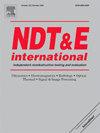Coherent and incoherent Rayleigh wave attenuation for discriminating microstructural effects of thermal damage from moisture conditions in concrete
IF 4.5
2区 材料科学
Q1 MATERIALS SCIENCE, CHARACTERIZATION & TESTING
引用次数: 0
Abstract
Thermal damage results in a depth-dependent variation in concrete mechanical properties, which is commonly investigated by invasive sampling and destructive testing. Ultrasonic Rayleigh wave (R-wave) testing offers a non-destructive alternative for mapping mild to moderate thermal damage in cementitious materials. However, the coupled influence of damage and moisture gradients on the ultrasonic measurements is not known, while it is known that rehydration causes partial recovery of mechanical properties. In this study, we prepare concrete and mortar blocks subjected to two distinct heating scenarios: a short-duration high-temperature exposure following the ISO fire standards, and a lower-intensity longer heating using radiant panels. We then use P-wave refraction, R-wave phase velocity and attenuation and diffuse field analysis to test the exposed blocks first at ambient conditions and later after water saturation, in order to decouple the influence of water saturation from that of thermal damage. The ultrasonic results are interpreted in relation to other non-destructive measurements: resistivity and capacitance. We find that although R-wave phase velocity is indeed sensitive to thermal damage, it is also significantly affected by the effect of moisture as it can hardly distinguish between exposed and intact surfaces after post-fire re-curing. In contrast, coherent R-wave attenuation effectively discriminates a damaged surface. The distinct analysis of coherent and incoherent attenuation enables to separate the impacts of thermal damage and moisture content. Overall, this article highlights the potential of attenuation for assessing damage under unknown moisture conditions.
用相干和非相干瑞利波衰减识别混凝土受潮条件下的微结构热损伤效应
热损伤导致混凝土力学性能随深度变化,通常通过侵入式取样和破坏性测试来研究。超声波瑞利波(r波)测试为胶结材料的轻度至中度热损伤测绘提供了一种非破坏性的选择。然而,损伤和水分梯度对超声测量的耦合影响尚不清楚,而已知复水化会导致力学性能的部分恢复。在本研究中,我们将混凝土和砂浆块置于两种不同的加热方案下:一种是遵循ISO防火标准的短时间高温暴露,另一种是使用辐射板的低强度长时间加热。然后,我们使用p波折射、r波相速度、衰减和扩散场分析来测试暴露区块,首先在环境条件下测试,然后在含水饱和后测试,以便将含水饱和度的影响与热损伤的影响分离开来。超声波的结果被解释为与其他非破坏性测量:电阻率和电容。我们发现,虽然r波相速度对热损伤确实很敏感,但它也受水分的影响很大,因为它很难区分火后再固化后暴露的表面和完整的表面。相比之下,相干r波衰减可以有效地识别受损表面。相干和非相干衰减的独特分析能够分离热损伤和水分含量的影响。总的来说,本文强调了在未知湿度条件下评估损害的衰减潜力。
本文章由计算机程序翻译,如有差异,请以英文原文为准。
求助全文
约1分钟内获得全文
求助全文
来源期刊

Ndt & E International
工程技术-材料科学:表征与测试
CiteScore
7.20
自引率
9.50%
发文量
121
审稿时长
55 days
期刊介绍:
NDT&E international publishes peer-reviewed results of original research and development in all categories of the fields of nondestructive testing and evaluation including ultrasonics, electromagnetics, radiography, optical and thermal methods. In addition to traditional NDE topics, the emerging technology area of inspection of civil structures and materials is also emphasized. The journal publishes original papers on research and development of new inspection techniques and methods, as well as on novel and innovative applications of established methods. Papers on NDE sensors and their applications both for inspection and process control, as well as papers describing novel NDE systems for structural health monitoring and their performance in industrial settings are also considered. Other regular features include international news, new equipment and a calendar of forthcoming worldwide meetings. This journal is listed in Current Contents.
 求助内容:
求助内容: 应助结果提醒方式:
应助结果提醒方式:


